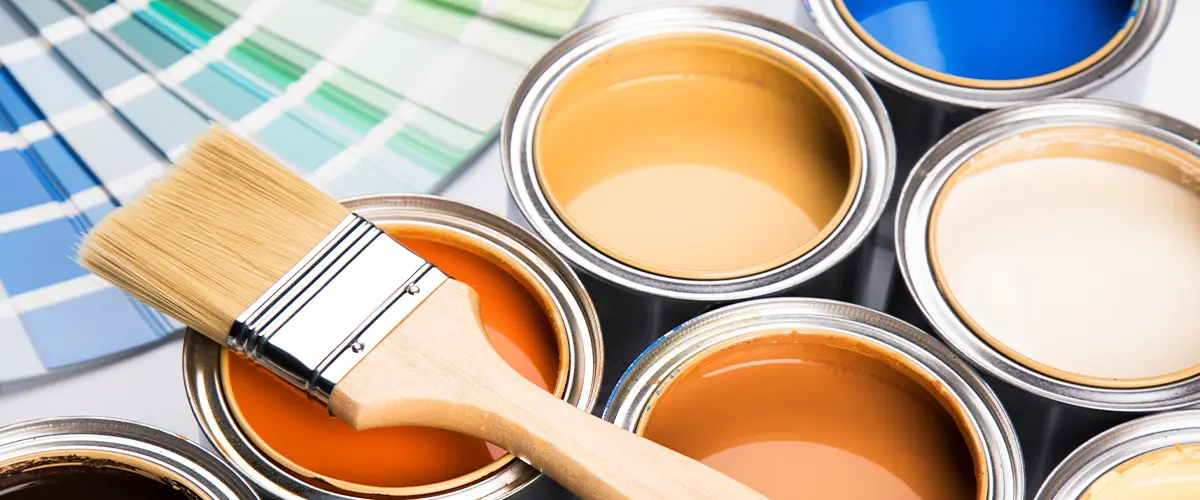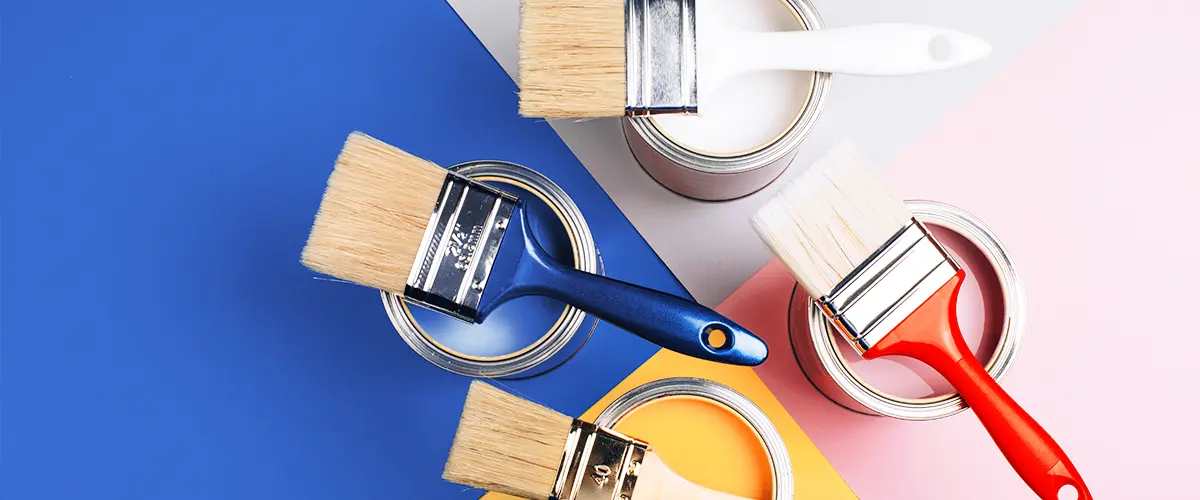Did you know that the sheen of your paint not only affects how it looks but also its durability?
Well, one thing we know for sure: choosing the right paint for your Virginia home can be a real head-scratcher.
This article will explore the ups and downs of both matte and flat paints so you can make an informed decision for your space.
Keep reading to find the perfect finish for your walls!

Differences between Matte and Flat Paint
When choosing between matte and flat paint for your Virginia home, it’s essential to understand how their distinct characteristics can impact the final look of your walls.
Matte paint offers a subtle glow that hides imperfections better than its flat counterpart, boasting an ultra-matte texture that absorbs more light.
Shine
Matte and flat paint offer unique levels of shine that affect the overall look of your VA home’s interiors. Matte paint boasts a low sheen, subtly reflecting light and giving walls a soft glow.
It’s an ideal choice for living areas where you want a gentle ambiance without the glare that glossier finishes can produce. On the other hand, flat paint offers no shine at all, providing an ultra-matte finish that absorbs light rather than reflecting it.
This quality makes flat paint excellent for ceilings or rooms where you desire zero distraction from surface imperfections.
As you consider how each type of paint will interact with the lighting in your home, also think about their ability to cover existing wall colors and marks.
Coverage
Moving beyond shine, let’s talk about how well these paints cover your walls. Flat paint offers excellent coverage with just one or two coats, making it a smart choice for evening-out walls with numerous imperfections.
Its ability to mask flaws is due to its high pigment concentration, which absorbs light and gives the illusion of a smoother surface. Matte paint also provides good coverage but may require an additional coat to achieve the same level of uniformity as flat paint.
Choosing between matte and flat finishes affects not just aesthetics but the number of gallons you’ll need. Flat paint can be more cost-effective for larger areas since it spreads more easily and covers better on the first application.
Remember that both types are porous; however, this means they’re also breathable—a feature that helps prevent mildew in VA homes’ humid climates. Deciding on the right sheen level involves balancing look against labor and longevity for your home improvement projects.
Blemishes
Transitioning from coverage, a key aspect to consider for VA homes is how these paint finishes handle blemishes. Matte and flat paints have an advantage here because of their non-reflective surfaces that excellently disguise imperfections such as nail holes or patches on walls.
The ability to hide these small flaws makes them ideal choices for older homes with plenty of character marks or areas prone to wear and tear.
Matte finish paint stands out by softening the appearance of blemishes even further due to its low shine quality. It can make wall dings and other small irregularities virtually disappear under its velvety texture.
On the other hand, flat paint’s ultra-matte finish goes one step beyond, offering supreme concealment of surface inconsistencies without drawing attention. It provides homeowners with a forgiving option when it comes to maintaining the look of their interior spaces over time.
Paint Finishes Comparison
| Aspect | Flat | Matte |
|---|---|---|
| Sheen Level | Flat Paint: Flat paint has the lowest level of sheen among all finishes. It reflects very little light, resulting in a matte appearance. Flat finishes are excellent for concealing surface imperfections but can be challenging to clean due to their porous nature. | |
| Durability and Washability | Flat Paint: Flat finishes are less durable and more challenging to clean compared to matte finishes. They are prone to scuffing and may not withstand regular washing, making them more suitable for low-traffic areas where cleaning frequency is minimal. | Matte Paint: Matte finishes are a bit more durable than flat finishes. While they are not as washable as higher sheen paints, they can handle light cleaning, making them suitable for areas with moderate traffic. |
| Application | Flat Paint: Flat finishes are often preferred for ceilings and walls in areas like bedrooms, living rooms, or dining rooms where a smooth and non-reflective surface is desired. | Matte Paint: Matte finishes are versatile and can be used in a variety of settings, including bedrooms, living rooms, and hallways. They strike a balance between a smooth appearance and a bit more washability. |
| Light Reflection | Flat Paint: Flat finishes absorb light, providing a deep, rich color without reflecting much light. This can make a room feel cozier and can be advantageous for minimizing glare. | Matte Paint: Matte finishes reflect slightly more light than flat paints, offering a soft, velvety appearance. They strike a balance between absorbing and reflecting light. |
Pros and Cons of Matte and Flat Paint

Matte Paint Pros: Low shine, less prone to show imperfections
Matte Paint offers homeowners a stylish, sophisticated look that pairs well with modern decor. Its low-shine surface absorbs light rather than reflecting it, which can make walls appear smoother.
This quality is especially beneficial in rooms where natural light varies throughout the day, as the constant change in lighting will be less likely to highlight imperfections.
Choosing matte paint means small dings or patches on walls become less of a concern. The finish’s ability to hide flaws makes it an ideal choice for older homes in VA with plenty of character and history behind their walls.
Walls painted with matte finishes tend to hold color well, offering a rich hue that stands out against other elements in your space without overwhelming them with glossiness.
Further Reading: What Are The Best Interior Paint Colors In 2024
Matte Paint Cons: Not as durable, difficult to clean
Matte paint, while stylish and modern for interior walls, presents a challenge in durability and maintenance. Its velvety texture can be appealing, but it’s more susceptible to damage than glossier finishes like satin or eggshell paint.
Scrapes and scuffs show up easily on matte surfaces due to its lack of sheen which doesn’t offer much protection against the wear and tear of daily life.
Cleaning matte-painted walls requires extra care because they’re less resistant to scrubbing. Harsh cleaning agents or vigorous washing can harm the finish, leaving unsightly marks on your once-pristine walls.
Choosing a matte finish could lead to more frequent touch-ups over time for high-traffic areas or spaces where messes are common—like kitchens or children’s rooms. It is not ideal for exterior paint applications either since it won’t hold up as well against harsh weather conditions compared to other paint sheens designed for outdoor use.
The porous nature of matte paint also means that dirt and grime can seep into the surface, making it harder to restore the original look without repainting.
Flat Paint Pros: Ultra-matte finish, hides imperfections
Flat paint offers homeowners a sleek, ultra-matte finish that’s highly sought after for its ability to make walls look impeccably smooth. It is especially effective in rooms where natural light tends to highlight bumps and small nicks because it absorbs light rather than reflecting it.
This quality makes flat paint a popular choice for older homes in VA with plenty of character since it can mask the quirks of aging plaster or drywall.
Choosing this type of finish can transform your space into an elegant setting with minimal effort. Flat paint excels at concealing those tiny imperfections that glossy paints might amplify.
As we consider options for different areas in the home, let’s explore why some finishes may not be as forgiving as flat paint when it comes to maintenance and touch-ups.
More to read: The Best Paint Primers On The Market In 2024
Flat Paint Cons: Less durable, can be difficult to touch up and clean
Choosing a flat finish for your interior paint can offer an elegant, non-reflective look that hides wall imperfections with ease. However, its porous nature makes it less durable compared to glossier paint sheen options like satin or eggshell paint.
This means in high-traffic areas of VA homes, walls coated with flat paint may show signs of wear and tear more quickly.
Cleaning poses another challenge; scrubbing stains off a flat painted surface could lead to discoloration since the porous texture absorbs cleaning agents and water differently than smoother finishes.
Touch-ups aren’t always seamless, either. Since the absorbed light varies by application, even small retouches might stand out against the original coat. Let’s explore how matte paints measure up in comparison to these factors.

Conclusion
So, both matte and flat paints are great, but it really depends on what you’re painting.
For interior painting of your home, maybe matte is not the right choice. It’s more expensive and upscale, and you don’t want the walls to be the centerpiece of your rooms. On the other hand, flat paint might work just fine.
Remember that both options have unique benefits that cater to specific needs. Factors like durability, cleaning ease, and aesthetic appeal are crucial in your choice.
Think about your lifestyle demands and which finish aligns with them best. Let your vision for each space guide you toward the right paint finish for a beautiful, lasting result.
For any upcoming painting projects with flat or matte paints, give us a call at (571) 253-5583 or request a free pricing quote to learn more about the costs associated with your upcoming project.
